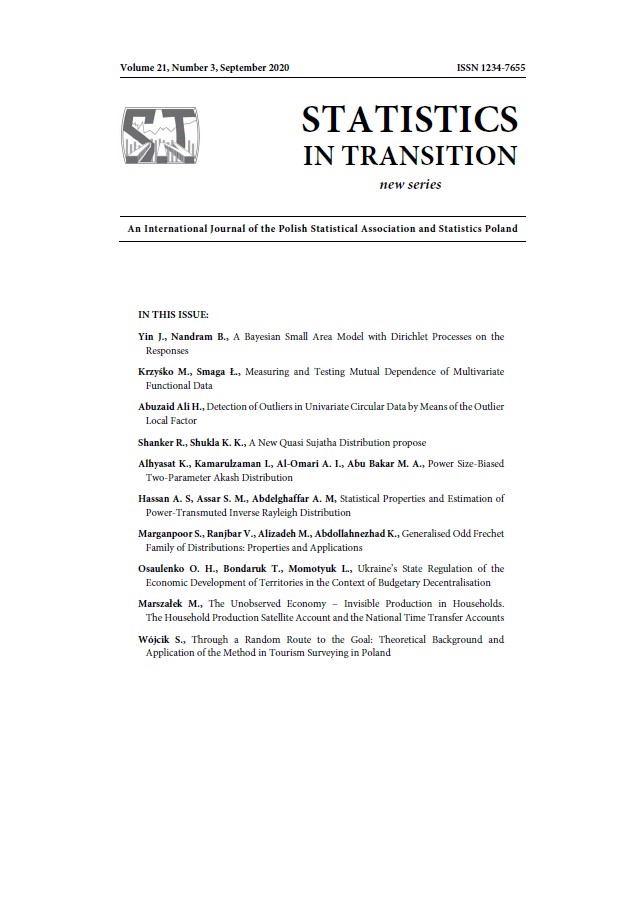ARTICLE
ABSTRACT
A new over-dispersed discrete probability model is introduced, by compounding the Poisson distribution with the weighted Ishita distribution. The statistical properties of the newly introduced distribution have been derived and discussed. Parameter estimation has been done with the application of the maximum likelihood method of estimation, followed by the Monte Carlo simulation procedure to examine the suitability of the ML estimators. In order to verify the applicability of the proposed distribution, a real-life set of data from the medical field has been analysed for modeling a count dataset representing epileptic seizure counts.
KEYWORDS
compounding model, coverage probability, simulation, count data, epileptic seizure counts
REFERENCES
ADIL, R., ZAHOOR, A., JAN, T. R., (2016). A new count data model with application in genetics and ecology. Electronic Journal of Applied Statistical Analysis, 9(1), pp. 213-226.
GERSTENKORN, T., (1993). A compound of the generalized gamma distribution with the exponential one, Recherches surles deformations, 16(1), pp. 5-10.
GERSTENKORN, T., (1996). A compound of the Polya distribution with the beta one, Random Operators and Stochastic Equations, 4(2), pp. 103-110.
GREENWOOD, M., YULE, G. U., (1920). An inquiry into the nature of frequency distribution representative of multiple happenings with particular reference to the occurrence of multiple attacks of disease or of repeated accidents, Journal of Royal Statistical Society, 83, pp. 255-279.
GUPTA, R. C., ONG, S. H., (2004). A new generalization of the negative binomial distribution, Journal of Computational Statistics and Data Analysis, 45, pp. 287-300.
LINDELY, D. V., (1958). Fiducial Distributions and Bayes theorem. Journal of the Royal Statistical Society, 20(1), pp. 120-107.
MAHMOUDI E., ZAKERZADEH H., (2010). Generalized Poisson-Lindely Distribution. Communications in statistics – Theory and Methods, 39(10), pp. 1785-1798.
PARA, B. A., JAN, T. R., (2018). An Advanced Discrete Model with Applications in Medical Science, Journal of Multiscale Modelling, 9(1), DOI: 10.1142/S1756973718500014, ISSN: 1756-9737 (print).
PARA, B. A., JAN, T. R., (2018). Discrete Inverse Weibull Beta Model: Properties And Applications In Health Science. Pakistan Journal of Statistics, 34(3), pp. 229-349.
PLACKETT, R. L., (1953). The truncated Poisson distribution. Biometrics, 9(4), pp. 485-488.
R CORE TEAM, (2019). R version 3.5.3: A language and environment for statistical computing. R Foundation for Statistical Computing, Vienna, Austria. URL https://www.R-project.org/.
ROSE, C. E., MARTIN, S. W., WANNEMUEHLER, K. A., PLIKAYTIS, B. D., (2006), On the use of zero-inflated and hurdle models for modeling vaccine adverse event count data, Journal of Biopharmaceutical Statistics, 16, pp. 463-481.
SHANKER, R., SHUKLA, K. K., (2017). Ishita distribution and its Applications, Biometrics & Biostatistics International Journal, 5(2), pp. 1–9.
SHUKLA, K. K., SHANKER, R., (2019). Weighted Ishita Distribution and Its Application to Survival Data, International Journal of Mathematics and Statistics, 20(1), pp. 67–82.
SKELLER, J. G., (1948). A probability distribution derived from the binomial distribution by regarding the probability of success as variable between the sets of trials, Journal of the Royal Statistical Society, Series B, 10, pp. 257-261.
ZAMANI, H., ISMAIL, N., (2010). Negative Binomial–Lindley Distribution And Its Application. Journal of Mathematics and Statistics, 1, pp. 4–9.
